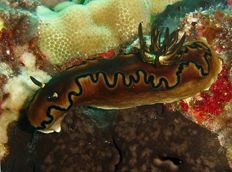| Home |
| Acknowledgments |
| Conventions |
| Glossary |
| Maps |
| References |
| Links |
| Articles |
| Thumbnails |
| Species
list |
| Family |
| Next
species |
Additional Photos

spread branchia

side

dark

feeding

egg mass

Doriprismatica atromarginata (Cuvier, 1804)

| Maximum size: 90 mm. Identification: This nudibranch has a high, narrow body with a mantle that covers the foot almost entirely (except for places where the margin folds and at the tip of the posterior end). Body color ranges from toasted-marshmallow brown to brownish black. The highly convoluted mantle margin is usually cream-colored and always possesses a striking black line. The rhinophore clubs and gill tips are black as well. The foot is cream. Hawaiian animals tend to be darker brown than those in other parts of its range. Natural history: While common in some parts of the world, such as Australia and Indonesia, Doriprismatica atromarginata is rarely sighted in Hawaii with only a few encounters in the main Hawaiian Islands. In most cases, several individuals were found feeding on a large black/brown sponge, Spongia oceania. (Note 1) They were in moderately exposed, rocky habitats ranging from 2-12 m (6-40 ft). The egg mass is white and hatches in about 10 days. Distribution: Maui, Oahu and French Frigate Shoals: widely distributed in the Indo-Pacific. Taxonomic notes: This species was first recorded in Hawaii from French Frigate Shoals before 1982 (Scott Johnson, pers. com.). The species name means black margin and, in the 5th printing, Hoover, 2006 lists it as Glossodoris atromarginata (corrected in 2019 printing) and refers to it as the "black-margin nudibranch." Photo: PF: on Spongia oceania with feeding damage: found by Michelle White; Molokini Islet, Maui; Nov. 6, 2007. Observations and comments: Note 1: On June 20 and June 29, 2008 we watched a pair of D. atromarginata attempt to feed on their host sponge. The nudibranch would begin to evert its oral tube and place it on the sponge but, within a few seconds, it would quickly recoil as if in pain and would remain in a reared back position for about 30 seconds before slowly placing its mouth on the sponge again. Sometimes instead of recoiling quickly it would pull back a little less vigorously, and attached to its mouth/head would be a long thin polychaete! When the nudibranch pulled back a centimeter or so, the polychaete would apparently let go and withdraw into the sponge. We watched this for 30 minutes each time and polychaetes continually attacked both nudibranchs on their heads and undersides wherever they attempted to feed. At times the nudibranchs would assume a "bridge" posture with only the tip of the foot and the head touching the sponge, seemingly in an attempt to prevent worms from attacking the foot and body. In spite of constant attacks, the nudibranchs seemed to be able to consume a tiny bit of sponge with each attempt as evidenced by many small scars. (see photos) Perhaps, the polychaetes were defending their host sponge in a manner analogous to Trapezia spp. defending Pocillopora spp. from crown of thorns sea stars? For further discussion of such interactions with another species of dorid see the Sea Slug Forum. |
| Thumbnails |
Species
list |
Family | Next species | Top |